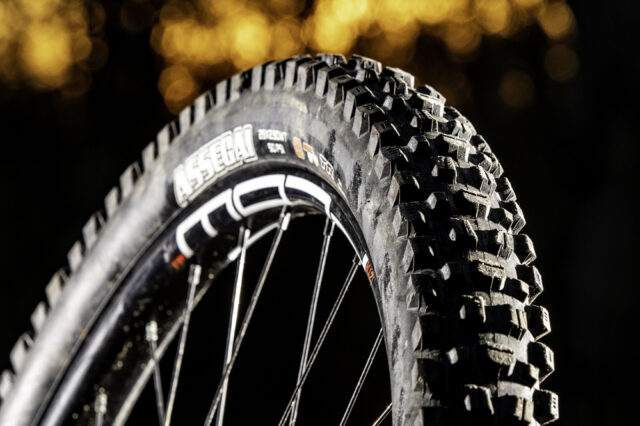Mountain bike tyres, whether you’re racing, training or riding a bike for fun, are an important part of your riding experience. However, the choice of which tyre to buy can be confusing, with manufacturers offering different types of rubber and casing, which all come with their own pros and cons. This guide aims to highlight the differences between trail, enduro and DH tyres, and how they differ from each other and the MTB tyre types.
Picking the right bike tyre for you can be a challenge, but here’s a guide to the best mountain bike tyres of the future.
Mountain bike tyres are not that much different from road tyres, in terms of design and function. However, there are exceptions, such as the new 20-inch by default, DH-specific, tread pattern of the Schwalbe Hans Dampf, which is perhaps the fastest and most aggressive mountain bike tyre to have appeared in the last years. The Hans Dampf is a 20-inch, DH-specific, tread pattern, with a width of 4.9 inches, which is also the widest width offered by Schwalbe.. Read more about best mountain bike tire for street and trail and let us know what you think.
Choosing the finest mountain bike tyres for your riding style and the circumstances you usually face may be a real pain. When done correctly, though, tyres may make a significant difference in how your bike rides.
Why is it so difficult to locate the correct tyres? To begin with, there is a lot of assumed information when it comes to MTB tyres.
You should know what a mud tyre should look like and where it performs best. You’ll need a good understanding of carcass thickness and rubber compound, as well as what kind of tread pattern performs best on flat or uneven terrain.
But don’t worry, we’ve already done the legwork for you.
We’ve included what each tyre is excellent for, what it’s intended for, if it’s available in various rubber compounds or carcass thicknesses, and which discipline it’s most suited to for each one.
When purchasing mountain bike tyres, there are a few things to keep in mind.
The significance of a good pair of tyres cannot be overstated. They have a significant impact on how your bike rides, so cutting corners is a waste of money. Finding the finest tyres for your requirements, on the other hand, is far from simple.
The importance of width cannot be overstated. Many manufacturers now offer 2.6in choices since wider tyres roll quicker over soft or rough terrain – in timed testing, we’ve regularly rode DH courses faster on them. A wider tyre, on the other hand, isn’t for everyone since it may have a bumpy ride and doesn’t fit all frames. You can try with hybrid bike tires also, they could be useful.
The tread pattern is also important to examine. Shorter tread blocks are quicker ‐ rolling and more predictable on hard ground, whereas tall, widely spaced knobs are excellent for muddy or sloppy terrain.
Most MTB tyres come in a variety of rubber compositions. Because the rubber absorbs more energy from bumps, softer compounds grip better on roots and pebbles and offer a more “grounded” riding feel. The disadvantages are that they wear out more quickly and have a higher rolling resistance.
Many tyres also available with a variety of casing options. Thicker carcasses are less prone to puncture and can generally be used at lower tyre pressures without the sidewall folding while cornering owing to stronger sidewalls. They’re also less bouncy over bumps since they have greater dampening.
Thinner casings roll quicker, particularly over uneven terrain, and convey less feedback for the same pressure.
Front and rear wheel tyres are getting more specialized. Rolling resistance and puncture resistance are more of a concern on the back, which bears the brunt of the rider’s weight, while grip is more essential up front to keep the front wheel from sliding out.
We’ve covered the fundamentals, but at the conclusion of the post, we’ve included an in-depth buyer’s guide and glossary to assist you discover precisely what you need.
Many of the MTB tyres we’ve recently tried and liked are geared toward trail and enduro riding, and this is reflected in our current selection. We’re working on additional tyre reviews and will only suggest tyres that we’ve tried and that are current models.
Our professional testers have chosen the best mountain bike tyres.
- Minion DHF Wide Trail 3C TR EXO Minion DHF Wide Trail 3C TR EXO Maxxis Minion DHF Wide Trail 3C TR EXO Maxxis Minion DHF Wide Trail 3 Maxxis Minion DHF Wide Trail 3
- Max Terra EXO Maxxis Shorty 3C
- Front Gum-X / Magi-X Michelin Wild Enduro
- SuperGravity ADDIX Soft by Schwalbe Hans Dampf
- SuperGravity ADDIX Soft Schwalbe Magic Mary
- SNAP WCE Top 40 Vee Tire Co
- Rear Gum-X Michelin Wild Enduro
- BLCK DMND BLCK DMND BLCK DMND BLCK DMND BLCK DM
- Hillbilly BLCK DMND SPECIALIZED
- 2.5 TCS Tough High Grip WTB Verdict
Maxxis Minion DHF Wide Trail 3C TR EXO
The Minion DHF Wide Trail 3C TR EXO 2.5in tyre from Maxxis.
Best for…
- Depending on the width, casing type, and compound, downhill, enduro, and trail riding may be done.
- Dust, pebbles, and roots abound in the hardpack.
- tyre on the front
The Minion DHF, perhaps the pinnacle of performance, is a favorite among gravity-fed DH and enduro riders as well as all-day trail blazers.
Its tried-and-true tread design provides consistent grip on a variety of trail conditions, and the big center blocks help it roll smoothly.
The Minion DHF’s main flaw is a lack of grip in suitably muddy and swampy situations.
We tried the DHF’s triple-compound 3C version, which provides the best combination of grip, damping, and suppleness, but there’s also a cheaper dual-compound DC version, and a DD version that’s strengthened for flat-out downhill riding.
The DHR II from Maxxis has a more aggressive tread design for more grip. It’s meant to be a rear tyre, but Maxxis claims it may also be used on the front.
Max Terra EXO Maxxis Shorty 3C
The Maxxis Shorty 3C EXO TR is quickly becoming a popular winter tyre in the United Kingdom. Immediate Media / Andy Lloyd
Best for…
- Depending on the casing, width, and compound of the tyre, it may be used for downhill, enduro, or trail riding.
- Deep, gloopy, and wet muck, as well as dust and loam, are examples of soft terrain.
- Whether it’s a front or rear tyre,
The Shorty is a mud-specific tyre with large, aggressive blocks that bite into soft ground to provide excellent traction.
The Shorty, despite its big blocky tread, clings pretty well after it dries up, and we’ve seen downhill and enduro riders utilize it in totally dry conditions with deep dust.
Front Gum-X / Magi-X Michelin Wild Enduro
The Michelin Wild Enduro tyre provides excellent grip, particularly in muddy situations. MBUK/Dan Milner
Best for…
- Enduro and downhill
- Deep, gloopy, and wet muck, as well as dust and loam, are examples of soft terrain.
- Also has excellent grip on rocks, roots, and rough terrain.
- tyre on the front
We were pleased by the Wild Enduro’s constant grip, owing to its big blocks that easily sink into soft terrain.
The rubber flexes and does not rebound fast, so its shoulders, although seeming square, offer predictable traction towards their limits.
But all of this grip comes at a price. They roll slowly, and the flexy sidewall may wiggle when ridden on hardpack portions if run at lower pressures.
SuperGravity ADDIX Soft by Schwalbe Hans Dampf
It performs well on rocky descents, particularly while braking. Poole, William
Best for…
- Depending on the carcass weight and rubber composition, downhill, enduro, and trail riding can be done.
- Rocks, roots, and hardpack
- tyre on the back
The Hans Dampf is best suited to rocky, hardpack terrain, with excellent straight-line grip and fast rolling speed. Because of its hefty side knobs, it’s also predictable when leaning over for cornering, and the ADDIX Soft rubber is nicely damped.
On soft, muddy ground, though, it isn’t nearly as effective.
SuperGravity ADDIX Soft Schwalbe Magic Mary
The SuperGravity enclosure provides lots of sidewall support. Andy Lloyd is a writer who lives in the United
Best for…
- Downhill, enduro, and trail riding are all popular types of riding.
- All kinds of terrain, from mud to hardpack, rocks, and roots
- Depending on your chosen discipline, lighter casing and various compositions are available.
- Whether it’s a front or rear tyre,
Thankfully, this Schwalbe tyre lives up to the “magic” portion of its name by offering excellent grip in wet situations while still giving enough of bite in turns and off-cambers.
Its big blocky tread and soft rubber composition make it equally grippy on hardpack, rocky terrain as it is on gentler ground, owing to its versatility.
It also rolls nicely, especially given its weight and tread compound.
SNAP WCE Top 40 Vee Tire Co
On the MTB scene, Vee Tire Co is becoming more well-known. Roo Fowler / Bike Connection
Best for…
- Downhill, enduro, and heavy trail riding are all popular.
- Rocks, roots, and hardpack
- Whether it’s a front or rear tyre,
It’s no surprise that the SNAP WCE Top 40 tyre performs well, thanks to sticky rubber and a tread design that mimics Maxxis’ Minion DHF.
Because of the sticky rubber, it grips wet rocks, roots, and trails well – as long as they aren’t too muddy. While the side knobs’ consistent squish means they’re very predictable when leaning over in turns.
The trade-off is a high degree of rolling resistance, and the tread pattern isn’t ideal for gloopy conditions.
Rear Gum-X Michelin Wild Enduro
This tyre shines the brightest on slick, muddy, and loose surfaces. Poole, William
Best for…
- Enduro and downhill
- All kinds of terrain, from mud to hardpack, rocks, and roots
- tyre on the back
The Wild Enduro has excellent turning grip, particularly in loose circumstances, due to its massive side knobs, and it clings well on wet roots and rocks.
The sidewall is quite thick since it’s a rear-specific tyre, thus it’s resistant to punctures and rips.
It also has closely spaced center tread blocks to assist with rolling resistance, which makes it less suitable for trail riding.
BLCK DMND BLCK DMND BLCK DMND BLCK DMND BLCK DM
On rough terrain, braking grip is excellent, and it stays put over bumps. Andy Lloyd is a writer who lives in the United
Best for…
- Lighter GRID casing for downhill, enduro, and trail.
- Rocks, roots, and hardpack
- tyre on the back
For aggressive riders and hard terrain, the rear-specific Eliminator with BLCK DMND housing is ideal.
Because of its rounded form, it carves turns effectively and can withstand being driven aggressively around corners at low pressures.
Even with this thick casing, it rolls smoothly, although it isn’t excellent in the mud or when the terrain is very loose.
Hillbilly BLCK DMND SPECIALIZED
This 2.6in version’s massive casing seems to provide significant flotation over very soft loamy areas. Andy Lloyd is a writer who lives in the United
Best for…
- Enduro and downhill
- Deep, gloopy, and wet muck, as well as dust and loam, are examples of soft terrain.
- Whether it’s a front or rear tyre,
The aggressive tread pattern of the Hillbilly contributes to it being one of the finest tyres we’ve rode in soft conditions, whether it’s wet, gloopy mud or hero soil like soft loam.
The sidewalls of the BLCK DMND casing are thicker, and there is less material beneath the tread of the tyre. On rocky terrain, this gives it a damped texture.
On wet rocks, it doesn’t always provide the greatest grip, but the grip available is usually predictable. Low cornering angles may cause it to give way rapidly due to its square shape.
2.5 TCS Tough High Grip WTB Verdict
It offers a pleasant, well-damped feel on the route, even through uneven terrain. Immediate Publication
Best for…
- Enduro and downhill
- Deep, gloopy, and wet muck, as well as dust and loam, are examples of soft terrain.
- Front tyre, although in extremely wet or soft circumstances, it may be used on the back.
The Verdict has excellent wet-weather traction, particularly on muddy, mushy terrain.
WTB manufactures a Wet version of the Verdict with even larger knobs, but we never thought the regular one required them. Its chemical also allows it to adhere to damp rocks and roots.
On hardpack trails or while leaning the bike over in corners, it doesn’t roll very quickly and isn’t particularly grippy or predictable.
Buyer’s guide for mountain bike tyres
The character and ride of your bike are greatly influenced by your tyres. We’ll show you what to look for when purchasing new mountain bike tyres.
Is it necessary for me to use tubeless tyres?
Tubeless-ready rims and tyres are standard on most bikes. Alex Evans is a writer who lives in the United
Traditional tyres are filled using an inner tube, but how do ‘tubeless’ tyres work?
Tubeless tyres do away with the inner tube in favor of a tyre that is specially engineered to be airtight, either with an extra layer of rubber or a latex-based sealant.
Mavic’s UST (Universal Technology Tubeless) system employs a thick sidewall tyre that is locked into a sealed-bed UST rim. The benefits include an airtight seal with or without a sealant liquid within, as well as highly stable, pinch puncture-resistant, low-pressure performance.
The disadvantages are that these tyres are more costly and heavier.
The majority of mountain bike tyres on the market today are tubeless compatible. These tyres have a tubeless bead, but they need sealant to be airtight. Rim tape is also required to seal the spoke holes.
This system has the advantage of being lighter than a complete UST system and providing the user with a broad range of tyre options.
The disadvantage is that since there is no universal standard among tyre and rim manufacturers, certain rim and tyre combinations perform better than others. Nonetheless, this will be the most frequent tubeless option you’ll come across.
Which is better: light mountain bike tyres or hefty mountain bike tyres?
The DHF has excellent turning ability and is suitable for most situations unless they get very muddy and swampy. Andy Lloyd is a writer who lives in the United
The weight of your bike has a significant impact on its agility and acceleration. Lighter tyres are simpler to spin up to speed, change direction, and even stop with, making them ideal for cross-country usage.
Because heavier tyres are thicker, they withstand punctures and pinch flats better and are less prone to flip and roll off at low pressures. The gyroscopic effect of the wheel is increased with heavier tyres, making the bike more stable on the ground or in the air.
Reinforced-carcass downhill tyres, on the other hand, are intended to be run at low pressures without popping or ripping off the rim, and depend on gravity to move their 1kg-plus weight.
What tyre width should I use on my mountain bike?
Greg Minnaar assisted in the development of the Maxxis Assegai tyres. Behr, Steve
From 1.5in to 5in fat bike tyres are offered in a wide variety of widths. The majority of mountain cyclists use 2.2in to 2.5in tyres, with 2.6in tyres becoming increasingly popular in recent years.
This series of tires provides excellent protection and grip for more aggressive riding. Narrower tyres provide less cushioning and have a smaller “footprint” on which to grip.
Unless smaller tyres are at higher pressures, pinch flat resistance is also lower. However, they are lighter and roll quicker, and they cut through sticky muck and gloop more effectively.
Square-profile tyres offer greater edging grip than round-profile tyres, but they are more difficult to lurch into bends. Rounder tyres slide more predictably and roll more readily into bends. However, the edge grip isn’t as strong.
There’s a huge variety of tyre sizes to choose from, ranging from 1.5in to 5in fat bike tyres. The majority of mountain cyclists use 2.2in to 2.5in tyres, with 2.6in tyres becoming increasingly popular in recent years.
Cross-country tyres are usually on the narrower side of the spectrum, while trail/enduro tyres are on the broader side. This series of tires provides excellent protection and grip for more aggressive riding.
Narrower tyres, on the other hand, provide less cushioning and have a smaller gripping surface. Pinch flat resistance is also reduced on smaller tyres, unless they’re being used at higher pressures, which may impair grip.
Narrower tyres, on the other hand, typically cut through sticky mud and gloop easier.
The optimum tyre width is ultimately determined by what you’re riding, where you’re riding, and how you’re riding. You can select the appropriate tyre by weighing all three factors.
Visit our ultimate test on mountain bike tyre size to determine the quickest width for trail and enduro riding for a more in-depth explanation.
Mountain bike tyres: how grippy are they?
The enduro and downhill compound featured in the Magic Mary and Dirty Dan is Addix Ultra Soft. Immediate Media / Russell Eich
This is determined by the tyre’s profile, tread pattern, durometer rating (the degree to which the rubber used in the tyre is soft), and general construction.
Larger gaps between tire blocks aid mud removal, while higher spikes grip better in slick situations. This kind of tread, on the other hand, has greater rolling resistance than a lower-profile, more closely spaced design and may wriggle over tougher terrain.
A square-profile tyre has greater edging grip but is more difficult to lurch into bends. Rounder tyres roll more smoothly into bends and slide more predictably in rough terrain. However, the edge grip isn’t as strong.
It’s a bit of a cliche, but a tyre that grips well thanks to a sticky/softer rubber compound and big square-edged knobs will generate more drag than one that doesn’t. However, certain noteworthy tyres that decrease drag via a minor slanting of tread patterns, various tread compounds, or the usage of a ‘fast’ carcass are included in this generalization.
Conversely, some tyres with very little tread bite just as well as mid-knob rubber.
To balance rolling resistance, grip, and durability, some tyres employ distinct compounds for the center and edge tread blocks.
All of this is dependent on the terrain in your area; for example, a very chunky aggressive tyre won’t bike as helpful on Moab’s slick rock as a lower profile tyre.
Glossary
- Shoulder: The off-camber and cornering gripping edge tread.
- The naked side of the tyre between the tread and the rim bread is known as the sidewall. Airtight on UST tyres for tubeless running; double or “two ply” on DH tyres for additional stability and pinch flat resistance.
- Damping refers to a tyre’s ability to absorb energy when it travels over a bump. More damping causes the tyre to rebound more slowly, resulting in a less bouncy ride with greater grip and control but increased rolling resistance.
- Bead: The steel wire or Kevlar cable at the base of the sidewall that secures the tyre to the rim lip. Kevlar or Aramid fiber beads are lighter and allow the tyre to fold, but they are more costly, and if flatted, the tyre is more prone to separate from the rim.
- The fabric body of the tyre is composed of overlapping nylon threads wrapped in rubber and is known as the carcass. A suppler carcass allows the tyre to flex over bumps for more traction, but it is less stable at low pressures. At low pressures, a strengthened carcass is more protective and less unstable, but it is heavier and less comfortable. Punctures are more prone to occur in lighter carcasses.
- The amount of threads per inch in the carcass is measured in TPI. Tyres with more threads are usually of better quality and have a more nuanced feel, although firms like Tioga utilize fewer fatter threads.
- Dual compounds are normally harder in the center or underneath for fast rolling and long life, but soft on the shoulders for cornering grip. Multi-compound: Tyres that use different rubber compounds; dual compounds are normally harder in the center or underneath for fast rolling and long life, but soft on the shoulders for cornering grip. Triple-compound tyres are now available from Schwalbe and Maxxis as well.
- Durometer: The rubber’s softness grade; anything over 70 is hard, 60 is medium, and anything below 50 is soft. The softer the tyre, the more sticky it is on rocks and other obstacles, but it will wear out quicker.
- Ramps: To reduce rolling resistance, ramped tread blocks feature a leading edge that is slanted like a wedge.
- Sipes: Tread blocks have little grooves carved into them to enable them to splay out like a goat’s hoof. Siped tyres provide better traction, particularly on wet terrain.
- During severe cornering, a tyre’s sidewall or tread folds, causing it to squirm.
When it comes to mountain bike tyres, the options are almost endless. When selecting a pair you’ll need to take into account a range of factors including the intended use of the bike, budget, your riding style and how much you’re willing to spend.. Read more about best 26 inch mountain bike tires and let us know what you think.
Frequently Asked Questions
What is the best brand of mountain bike TYRE?
The best brand of mountain bike tyre is the Schwalbe Marathon Plus.
Are Enduro bikes good for trail riding?
Enduro bikes are good for trail riding because they can handle the rough terrain and bumps.
What are the best tires for trail riding?
The best tires for trail riding are the ones that you can afford.
Related Tags
This article broadly covered the following related topics:
- best mountain bike tire for street and trail
- best 29er mountain bike tires
- best mountain bike tyre combination
- best 26 inch mountain bike tires
- best mtb tyres all round







